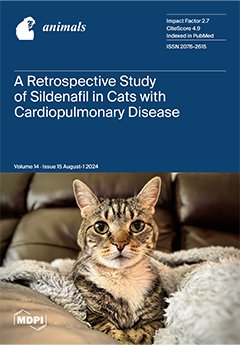The objective of this study was to examine the effects of varying levels of dietary chitosan supplementation on mitigating cadmium stress and its influence on growth performance, serum biochemical indices, antioxidant capacity, immune response, inflammatory response, and the expression of related genes in juvenile Genetically Improved Farmed Tilapia (GIFT,
Oreochromis niloticus). Five groups of juvenile tilapias (initial body weight 21.21 ± 0.24 g) were fed five diets with different levels (0%, 0.5%, 1.0%, 1.5%, and 2.0%) of chitosan supplementation for 60 days under cadmium stress (0.2 mg/L Cd
2+). The findings indicated that, compared with the 0% chitosan group, dietary chitosan could significantly increase (
p < 0.05) the final weight (Wf), weight gain rate (WGR), specific growth rate (SGR), daily growth index (DGI), and condition factor (CF), while the feed conversion ratio (FCR) expressed the opposite trend in juvenile GIFT. Dietary chitosan could significantly increase (
p < 0.05) the activities (contents) of cholinesterase (CHE), albumin (ALB), lactate dehydrogenase (LDH), alkaline phosphatase (ALP), acid phosphatase (ACP), and lysozyme (LZM), while glutamic pyruvic transaminase (GPT), glutamic oxaloacetic transaminase (GOT), and complement 3 (C3) in the serum of juvenile GIFT expressed the opposite trend. Dietary chitosan could significantly increase (
p < 0.05) the activities of superoxide dismutase (SOD) and catalase (CAT) and significantly decrease (
p < 0.05) the activities (contents) of glutathione S-transferase (GST), glutathione peroxidase (GSH-Px), and malondialdehyde (MDA) in the serum of juvenile GIFT. Dietary chitosan could significantly increase (
p < 0.05) the activities (contents) of CAT, GST, GSH-Px, and total antioxidant capacity (T-AOC) and significantly decrease (
p < 0.05) the contents of MDA in the liver of juvenile GIFT. Dietary chitosan could significantly increase (
p < 0.05) the activities (contents) of SOD, GSH-Px, T-AOC, Na
+-K
+-ATPase, and Ca
2+-ATPase and significantly decrease (
p < 0.05) the activities (contents) of CAT, GST, and MDA in the gills of juvenile GIFT. Dietary chitosan could significantly up-regulate (
p < 0.05) the gene expression of
cat,
sod,
gst, and
gsh-px in the liver of juvenile GIFT. Dietary chitosan could significantly up-regulate (
p < 0.05) the gene expression of interferon-γ (
inf-γ) in the gills and spleen and significantly down-regulate (
p < 0.05) the gene expression of
inf-γ in the liver and head kidney of juvenile GIFT. Dietary chitosan could significantly down-regulate (
p < 0.05) the gene expression of interleukin-6 (
il-6),
il-8, and tumor necrosis factor-α (
tnf-α) in the liver, gills, head kidney, and spleen of juvenile GIFT. Dietary chitosan could significantly up-regulate (
p < 0.05) the gene expression of
il-10 in the liver, gills, head kidney, and spleen of juvenile GIFT. Dietary chitosan could significantly up-regulate (
p < 0.05) the gene expression of transforming growth factor-β (
tgf-β) in the liver and significantly down-regulate (
p < 0.05) the gene expression of
tgf-β in the head kidney and spleen of juvenile GIFT. In conclusion, dietary chitosan could mitigate the impact of cadmium stress on growth performance, serum biochemical indices, antioxidant capacity, immune response, inflammatory response, and related gene expression in juvenile GIFT. According to the analysis of second-order polynomial regression, it was found that the optimal dietary chitosan levels in juvenile GIFT was approximately 1.42% to 1.45%, based on its impact on Wf, WGR, SGR, and DGI.
Full article






